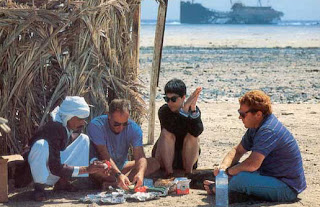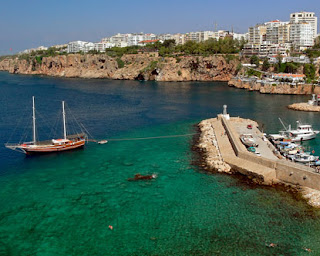Geography
Turkey is at the northeast end of the Mediterranean Sea in southeast Europe and southwest Asia. To the north is the Black Sea and to the west is the Aegean Sea. Its neighbors are Greece and Bulgaria to the west, Russia, Ukraine, and Romania to the north and northwest (through the Black Sea), Georgia, Armenia, Azerbaijan, and Iran to the east, and Syria and Iraq to the south. The Dardanelles, the Sea of Marmara, and the Bosporus divide the country. Turkey in Europe comprises an area about equal to the state of Massachusetts. Turkey in Asia is about the size of Texas. Its center is a treeless plateau rimmed by mountains.
History
Anatolia (Turkey in Asia) was occupied in about 1900 B.C. by the Indo-European Hittites and, after the Hittite empire's collapse in 1200 B.C. , by Phrygians and Lydians. The Persian Empire occupied the area in the 6th century B.C. , giving way to the Roman Empire, then later the Byzantine Empire. The Ottoman Turks first appeared in the early 13th century, subjugating Turkish and Mongol bands pressing against the eastern borders of Byzantium and making the Christian Balkan states their vassals. They gradually spread through the Near East and Balkans, capturing Constantinople in 1453 and storming the gates of Vienna two centuries later. At its height, the Ottoman Empire stretched from the Persian Gulf to western Algeria. Lasting for 600 years, the Ottoman Empire was not only one of the most powerful empires in the history of the Mediterranean region, but it generated a great cultural outpouring of Islamic art, architecture, and literature.
After the reign of Sultan Süleyman I the Magnificent (1494–1566), the Ottoman Empire began to decline politically, administratively, and economically. By the 18th century, Russia was seeking to establish itself as the protector of Christians in Turkey's Balkan territories. Russian ambitions were checked by Britain and France in the Crimean War (1854–1856), but the Russo-Turkish War (1877–1878) gave Bulgaria virtual independence and Romania and Serbia liberation from their nominal allegiance to the sultan. Turkish weakness stimulated a revolt of young liberals known as the Young Turks in 1909. They forced Sultan Abdul Hamid to grant a constitution and install a liberal government. However, reforms were no barrier to further defeats in a war with Italy (1911–1912) and the Balkan Wars (1912–1913). Turkey sided with Germany in World War I, and, as a result, lost territory at the conclusion of the war.
Cities of Turkey
ISTANBUL
Istanbul historically Byzantium and Constantinople; is the largest city in Turkey, largest city proper and second largest metropolitan area in Europe, and fourth largest city proper in the world with a population of 12.6 million. Istanbul is also a mega city, as well as the cultural and financial center of turkey. The city covers 27 districts of the Istanbul province. It is located on the Bosporus strait and encompasses the natural harbor known as the golden horn, in the northwest of the country. It extends both on the European (Thrace) and on the Asian (Anatolia) sides of the Bosporus, and is thereby the only metropolis in the world that is situated on two continents.



In its long history, Istanbul has served as the capital city of the Roman Empire (330–395), the (Byzantine) East Roman Empire (395–1204 and 1261–1453), the Latin Empire (1204–1261), and the Ottoman Empire (1453–1922). The city was chosen as joint European Capital of culture for 2010. The historic areas of Istanbul were added to the UNESCO world heritage list in 1985.
Istanbul is an old city; you can see the remains of many ancient civilizations and their culture in harmony with Turkish culture. The old versus the new, the traditional versus the modern is a conflict a visitor often observes. The city is full of contrasts, and colorful views.
ANKARA
Very familiar to most people as the capital of Turkey, Ankara is actually only the country's second-biggest city, being considerably smaller than Istanbul. However, Ankara is actually a very large and presentable Turkish city, constantly expanding and offering a rather sophisticated and modern character. Many wide streets are now lined with coffee shops and eateries, particularly around the energetic Kizilay area.
Various tourist hotspots present themselves around the city of Ankara and in particular, along the Ataturk Bulvari, which serves as a prominent artery. The Ulus Meydani, known simply as 'Ulus', is another important tourism hub in the city and this central square is close to a number of leading museums, while also offering a choice of accommodation and inexpensive restaurants. Nearby, the Ankara Tourist Information Office is easy to find and stands directly opposite the Maltepe Akaray Train Station, on the Gazi Mustafa Kemal Bulvari.


Although Ankara is somewhat overshadowed by the enormous Turkish city of Istanbul, but really does compete well in the way of quality tourist attractions. The city's Citadel walls are positively ancient and comprise a mixture of different architectural styles through the ages. Also of a great age and much visited are the Roman Baths of Ankara, which remain is a good state of repair, considering that they are more than 1,700 years old. The Ataturk Mausoleum is yet another major sight, while for families, the attractions within the Ataturk Forest Farm and Zoo and Aquapark Club Watercity comes highly recommended.
ANTALYA
Antalya (formerly known as Adalia; from Pamphylian Greek: Αττ?λεια Attália) is a large town and tourist destination, situated on the Mediterranean coast of southwestern Turkey. It is the capital city of Antalya Province. The population of the city is 603,190 (2000 census) but reaches up to two million in summers at the height of tourism season.
Situated on a steep cliff over the Mediterranean, Antalya is a picturesque city surrounded by mountains. Developments in tourism, starting in the 1970s, have transformed the city into an international resort. With its airport and central location, Antalya is "the capital of Turkish tourism", a gateway for the Turkish riviera and many historical sites. Furthermore, with its palm-lined boulevards, its prize-winning marina, the unspoilt historical neighbourhood of Kaleiçi, and the modern developments along the coast, the city of Antalya is a major attraction in its own right. Antalya and its surroundings are a very important part of Turkish tourism.
|
|
Antalya city corresponds to the lands of ancient Pamphylia to the east and Lycia to the west. Antalya has plenty of accommodation, a very hot climate and many places to visit both in and around the city, including traces of Lycian,Pamphylian, Hellenistic, Roman, Byzantine, Seljuk and Ottoman architecture and cultures.
The city as a whole has grown huge now and the infrastructure such as roads and drains are struggling to catch up, but there are still areas that are very attractive indeed: Kaleiçi, with its narrow cobbled streets of historic Turkish and Greek houses is the old center of Antalya, now mainly hotels, gift shops, and many, many bars. The big new hotels such as the Sheraton are along the coast above the Konyaalti and Lara beaches, and indeed spread along the coast in both directions far beyond the city of Antalya itself.
KUSADASI
Early settlements in Kusadasi were by the Lelegians and Carians who moved from the central Anatolia around the year 3000BC. They established of a colony on the outskirts of Pilav Mountain in Kusadasi, and founded the cities Ania and Melia. Mild climate allowed the inhabitants to grow essential products such as olive, grape and figs for extracting oil or making wine and sweets on the fertile lands around the city.
In the 10th century BC "12 Ionian Cities "-Samos, Khios, Miletos, Priene, Ephesus, Teos, Erythrai, Priena, Klazonemi, Lebedos, Phokaia, Colophon, Smyrna, were established and were known for the most developed cities of the age. The annual meeting place of the Ionian League, Panionian, was founded around Kusadasi; and the cities of Phygale, Marathesion and Neopolis were established within the borders of the city.

Kusadasi was ruled by the Ottoman Empire after the invasion of Sultan Mehmet Celebi in the year 1413. During the reign of Ottomans, glorious new structures were built in Kusadasi Okuz Mehmet Pasa Caravanserai is the principal legacy of the Ottoman architecture in the city, and was built by the man of the same name, who was the vizier during the reigns of Sultan Ahmet1 and Osman2. The fortress is gates and walls and many mosques in the centre of Kusadasi, as well as the citadel of the castle in Pigeon Island, were built in the Ottoman period, reflecting the architectural style of the era. "Kusadasi " that means "bird island" and took its name from Pigeon Island.
Today, Kusadasi is one of Turkey's most sophisticated holiday centres; it is a perfect place for vacation with its sandy beaches and glassy water. The contrast between the lively holiday life and the quietness of the ancient ruins create the special atmosphere of the city.


































































































